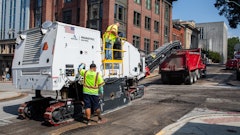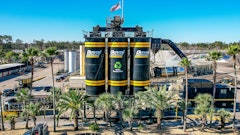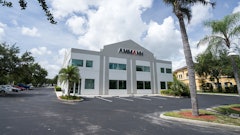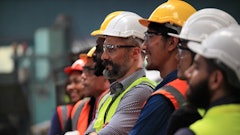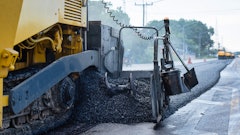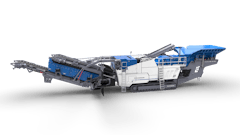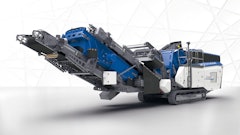When Barriere Construction Co. brought its new Stansteel dual-drum counterflow 400-tph hot mix asphalt plant on line in January 1999, the goal of making the facility a reliable, high-production operation was clearly stated by company management, and a continuous improvement process has kept it that way ever since.
The company, which operates four divisions serving asphalt production/paving, concrete paving, utility site preparation and construction, and commercial concrete structural and foundation work, generates $100 million in annual revenue, with asphalt production/paving representing 60 percent of its business.
The Boutte operation represents 60 percent of Barriere's asphalt business, with 90 percent of total HMA production used to support three paving crews and the other 10 percent sold to retail customers. Daily production runs between 1,000 and 3,000 tons. The plant has five 250-ton silos, with a sixth silo scheduled to be brought on-line by the first of the year. The plant also went from seven to 10 cold-feed bins to improve productivity with the many mix designs required to fill daily orders.
"We run numerous mix designs on a daily basis to fill the needs of our customers. So in order to maintain the production levels we want coming out of the plant, we've invested in storage capacity (silos) and material handling (cold-feed bins) to limit interruptions when switching from one mix design to another," says Bert Wilson, senior vice president in charge of the Boutte operation. "With the different materials (aggregates) required for the mix designs specified by our customers, we decided to invest in more cold-feed bins rather than stop production to empty bins to accommodate different materials."
While most of Barriere's asphalt customers have adopted mix designs specified by the Louisiana Department of Transportation Development, it's not uncommon for individual customers, whether they're government agencies at the local parish (county) level or private commercial accounts, to request a slight variation to the approved LDOT designs. Customers tend to stick with mix designs they've used for years and they're reluctant to switch to a recommended alternative.
"We try to match the mix design for the application it's intended to serve," Wilson says. "If it's a Level 3 Superpave design, we know the mix has to accommodate a heavy traffic load and provide a long service life. But we also know we're dealing with a lot of individual customers who have their own opinions of what works for them, and so we maintain the materials to accommodate approximately 30 different mix designs."
Since much of Barriere's quality aggregate is shipped by barge from a Kentucky quarry, the company maintains approximately 25,000 tons of aggregate at its Boutte facility. Maintaining such a large inventory of raw material is part of the company's commitment to managing a reliable asphalt production facility.
Total Process Reliability
When Barriere invested in its Boutte Stansteel plant, the company's intent was to replace several other area production facilities as well as accommodate future growth.
"At the time, we made a commitment to buy the best and maintain it to be a reliable, high-production facility," Wilson says. "At about the same time, we initiated our Total Process Reliability (TPR) program, which evaluates the life cycle of each component in order to determine when to replace a component before it fails."
Shortly after the plant was brought on-line, Kevin Ervin, operations manager, joined the company, and he has been instrumental in making the TPR program a reality.
"My goal in coming here was to make this a production line-type of facility," Ervin says. "The company wanted this facility to be the backbone of its asphalt operation, and I was given the responsibility of operating and maintaining a reliable, high-production facility at this location."
Using monitoring devices and evaluation tools like infrared heat sensors, as well as working with outside services to conduct periodic analysis of the plant's operating components, Ervin has been able to schedule the plant's maintenance needs to mesh with its project scheduling needs.
"We take a preventive maintenance approach on the major plant components by tracking the tonnage produced to determine when a component wears out, when it's likely to fail and cause unscheduled downtime," Ervin says. "If a bearing is likely to fail after 100,000 tons of production, then we want to schedule replacing that bearing at 95,000 tons of production. Our goal is to move from a preventive maintenance approach to a predictive maintenance approach."
Barriere's TPR program, or operating philosophy if you will, is intended to keep the plant running when projects are scheduled to be filled. It's really that simple, and the company has managed to limit its unscheduled downtime to just a couple days a year.
The frequent equipment analysis Ervin conducts, whether it's a vibration analysis on an electric motor or gearbox, or a temperature fluctuation on a control panel, also enables the company to make a decision on whether a scheduled shutdown is required, or simply let the component fail because it's a minor repair that can be handled with little disruption to the day's production schedule.
Ervin uses an outside service to conduct a 100-point infrared temperature analysis of the plant, with information gathered used to set alarms at predetermined temperatures to alert plant operators that a potential problem exist with a motor, bearing or gearbox. He also conducts a vibration and oil analysis of all major gearboxes.
"Our motor dealer stocks the motors we use at the plant and he also conducts vibration test of our motors during operation," Ervin says. "We stock about $10,000 worth of replacement parts, but those items are more of the common maintenance parts, like belts and hoses, and other smaller items."
For major maintenance, Ervin schedules a one-week shutdown each year between Christmas and New Year's. The company invests approximately $100,000 on parts, labor and equipment rental each year to replace major components and refurbish others. The most recent overhaul included a new dryer chain and sprocket, a dryer idler and bearings, silo liner seam plates, silo clam door pins, drag floor and sideliners, drag gearbox, drag drive chain, drag drive sprocket, and drag motor.
Ervin uses Microsoft Project Manager to schedule maintenance activities during the shutdown. Just like scheduling an actual project, Ervin uses the software to identify the parts, people, time, equipment and safety requirements for the weeklong maintenance overhaul. It allows him to contact outside help, whether it's an electrician or a crane operator, as well as schedule equipment rentals required to safely complete the maintenance work. It also allows him to review the upcoming maintenance work with the plant personnel weeks and even months prior to the scheduled shutdown.
"This plan allows us to know hour-to-hour what needs to happen in order to complete the required maintenance we've scheduled for a seven to eight-day shutdown," Ervin says. "It also makes it clear when our outside help needs to be here and when they need to complete their work so we can move on to the next step of the maintenance schedule."
For Barriere's Boutte HMA operation, success in running a high-production facility is the result of having good people who are focused on optimizing the plant's capabilities through improvements and upgrades, and then scheduling preventive maintenance to minimize unscheduled downtime.
RF efficiency
To further streamline and enhance productivity at Barriere's Boutte plant, the company installed a radio frequency reader system in 2004. The $60,000 investment for the load-out system covered the RF readers for all the independent truckers who haul for Barriere, the software to integrate the system with the plant's operating software, and time to get the system running. Additional internal expenses for electrical work and site construction were required, but the investment has already paid dividends in reduced paper processing costs and labor to operate the plant.
"We do a lot in cycle time tracking to evaluate how long it takes to get a truck through the plant and identify where the bottlenecks are," says Kevin Ervin, operations manager.
Crunch time at the plant is early in the day when scheduled independent truckers line up for their first load of the day.
"We looked at the time it took for a trucker to check in, spray their truck box, load their asphalt, check out and be on their way to the project they were supplying, and we recognized how much time they were spending out of their truck and how much time we were spending doing paperwork," Ervin says.
With two plant operators trying to load out 400 to 600 tons per hour during that early morning crunch, one operator would typically spend 50 percent of his time on paperwork required in loading trucks.
Now, one operator can handle the same workload and truckers are moving through the yard more efficiently. Here's how it works.
When a trucker enters the plant, a RF reader logs the trucker in and a message board tells the trucker what scale and what silo (the mix for the project he's supplying) he needs to go to. Then the trucker pulls up to an automatic box sprayer before heading to the scale located in front of the load-out silos. Another RF reader at the scale notifies the control room operator that the truck is ready for loading. It eliminates communication between the truck driver and control room, and any possible confusion of the mix to be loaded. When the truck is loaded, a horn blows and the driver then pulls forward to a window-high printer to pick up a ticket before covering the load with a tarp and heading out to his assigned project.
"The system not only moves the truckers through the yard a lot quicker, it also helps to trend the cycle time of how long it takes a truck driver to load, get to the job and then back to the plant," Ervin says. "It also lets our project foremen know when a truck is on the way."
Before the system was installed truck drivers would call to find out where to go, and project foremen would call to find out where a truck was. Now, truck drivers know exactly what to do and project foremen (through text messaging on their cell phones) receive a status report on when a truck has been loaded and sent on its way.
To further streamline its loading system, Barriere will require truck drivers to install automatic tarping systems. The requirement will be phased in as drivers need to replace worn tarps, but it's another step toward improving the plant's productivity.









